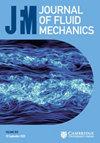与垂直气缸二次载荷循环相关的准脉冲后向波力的实验研究
IF 3.9
2区 工程技术
Q1 MECHANICS
引用次数: 0
摘要
垂直圆柱体(支撑海上风力涡轮机的典型地基)上的陡峭波浪会引起猛烈荷载。关于重要的剧烈波浪载荷和相关的二次载荷循环的许多问题仍未得到解答。我们利用单向波的实验室实验来研究垂直圆柱体上的流体载荷。我们采用了一种新颖的三相分解方法,该方法允许我们分离不同类型的非线性。我们的研究结果表明,存在一个额外的准脉冲加载分量,它与二次加载循环相关,并发生在与入射波相反的反方向上。这种准脉冲力发生在二次加载周期的末端,接近于未扰动波的向下零交叉点。小波分析表明,脉冲力的表现与典型的海浪冲击事件表面相似,但方向相反。为了监测散射波场并提取圆柱体上的上升力,我们安装了一个四摄像头同步视频系统,并发现 II 型散射波到达圆柱体的时间与这种准脉冲力的发生之间具有很强的时间相关性。这种准脉冲力的时间特征可以用 Goda 波撞击模型来近似表示,该模型以 II 型散射波在后停滞点的碰撞为撞击源。本文章由计算机程序翻译,如有差异,请以英文原文为准。
An experimental study of a quasi-impulsive backwards wave force associated with the secondary load cycle on a vertical cylinder
Steep wave breaking on a vertical cylinder (a typical foundation supporting offshore wind turbines) will induce slam loads. Many questions on the important violent wave loading and the associated secondary load cycle remain unanswered. We use laboratory experiments with unidirectional waves to investigate the fluid loading on vertical cylinders. We use a novel three-phase decomposition approach that allows us to separate different types of nonlinearity. Our findings reveal the existence of an additional quasi-impulsive loading component that is associated with the secondary load cycle and occurs in the backwards direction against that of the incoming waves. This quasi-impulsive force occurs at the end of the secondary load cycle and close to the passage of the downward zero-crossing point of the undisturbed wave. Wavelet analysis showed that the impulsive force exhibits superficially similar behaviour to a typical wave-slamming event but in the reverse direction. To monitor the scattered wave field and extract run-up on the cylinder, we installed a four-camera synchronised video system and found a strong temporal correlation between the arrival time of the Type-II scattered wave onto the cylinder and the occurrence of this quasi-impulsive force. The temporal characteristics of this quasi-impulsive force can be approximated by the Goda wave impact model, taking the collision of the Type-II scattered waves at the rear stagnation point as the impact source.
求助全文
通过发布文献求助,成功后即可免费获取论文全文。
去求助
来源期刊
CiteScore
6.50
自引率
27.00%
发文量
945
审稿时长
5.1 months
期刊介绍:
Journal of Fluid Mechanics is the leading international journal in the field and is essential reading for all those concerned with developments in fluid mechanics. It publishes authoritative articles covering theoretical, computational and experimental investigations of all aspects of the mechanics of fluids. Each issue contains papers on both the fundamental aspects of fluid mechanics, and their applications to other fields such as aeronautics, astrophysics, biology, chemical and mechanical engineering, hydraulics, meteorology, oceanography, geology, acoustics and combustion.

 求助内容:
求助内容: 应助结果提醒方式:
应助结果提醒方式:


